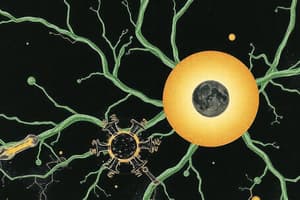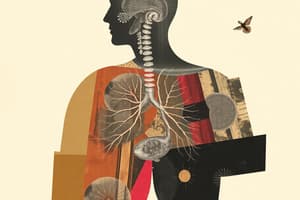Podcast
Questions and Answers
What is the role of ATP in cellular processes?
What is the role of ATP in cellular processes?
- Serves as the primary energy currency of the cell (correct)
- Acts as a source of genetic information
- Functions solely in aerobic respiration
- Transports oxygen within the cells
Which of the following directly describes the process of catabolism?
Which of the following directly describes the process of catabolism?
- Synthesizing ATP from ADP
- Storing energy within chemical bonds
- Building complex molecules from simple ones
- Breaking down complex molecules into simpler ones (correct)
Which of these statements about the hydrolysis of ATP is true?
Which of these statements about the hydrolysis of ATP is true?
- It is an endergonic reaction that requires energy.
- It is an exergonic reaction that releases energy. (correct)
- It involves the synthesis of ATP from ADP.
- It can only occur in the presence of oxygen.
What distinguishes the process of photosynthesis from chemosynthesis?
What distinguishes the process of photosynthesis from chemosynthesis?
Which process is primarily responsible for the metabolic pathway that breaks down glucose?
Which process is primarily responsible for the metabolic pathway that breaks down glucose?
What component is primarily involved in how cells transform energy?
What component is primarily involved in how cells transform energy?
What is the main function of the outer membrane of mitochondria?
What is the main function of the outer membrane of mitochondria?
In which compartment of the mitochondrion does the Krebs cycle occur?
In which compartment of the mitochondrion does the Krebs cycle occur?
Which scientist first discovered mitochondria?
Which scientist first discovered mitochondria?
What is meant by 'free energy' in biological terms?
What is meant by 'free energy' in biological terms?
What is the primary role of cristae in the mitochondrion?
What is the primary role of cristae in the mitochondrion?
What defines a coupled reaction in biological systems?
What defines a coupled reaction in biological systems?
What is the primary function of mitochondria in cells?
What is the primary function of mitochondria in cells?
What is the primary purpose of food for the body?
What is the primary purpose of food for the body?
What distinguishes aerobic respiration from anaerobic respiration?
What distinguishes aerobic respiration from anaerobic respiration?
Which equation correctly represents aerobic respiration?
Which equation correctly represents aerobic respiration?
What is produced during anaerobic respiration in muscle cells?
What is produced during anaerobic respiration in muscle cells?
What is the first pathway of aerobic respiration?
What is the first pathway of aerobic respiration?
Which of the following is the second stage of cellular respiration?
Which of the following is the second stage of cellular respiration?
In which stage is most of the carbon dioxide formed during respiration?
In which stage is most of the carbon dioxide formed during respiration?
Which compound is known as Citric Acid in the Krebs Cycle?
Which compound is known as Citric Acid in the Krebs Cycle?
Flashcards are hidden until you start studying
Study Notes
What is Energy?
- Energy is required for living things to maintain order, grow and reproduce
- Bioenergetics is the branch of biochemistry focusing on how cells transform energy
- Chemical energy is stored in the bonds of molecules and can be released and transformed by metabolic pathways
- Free Energy (G) is the chemical energy available to do work
Why Life Requires a Highly Ordered System?
- Living organisms require a highly ordered system to maintain life
Mitochondria
- Mitochondria are often referred to as the “powerhouses of the cell”
- Discovered by Rudolph Albert von Kolliker in 1857
Mitochondria Structure
- Two separate membranes: an inner and outer membrane
- Three compartments: intermembrane space, cristae space, and matrix
Outer Membrane
- Acts as a molecular sieve allowing only small molecules to diffuse through
Inner Membrane
- Folds to form cristae that divide the organelle into three compartments
- Where the third stage of cellular respiration, the Electron Transport Chain, takes place
Intermembrane Space
- Located between the inner and outer membrane
- Involved in regulating respiration and metabolic functions
Cristae
- High curvature structures in the inner mitochondrial membrane (IMM) that are crucial for ATP production
Matrix
- Space enclosed by the inner membrane
- The second stage of cellular respiration, the Krebs Cycle, takes place in the matrix
Antoine Lavoisier
- Related chemistry to the science of bodies, physiology, and the study of metabolism and respiration
Coupled Reactions
- A class of organic reactions that involve the joining of two chemical species
- Increase entropy
Krebs Cycle
- Also known as the Citric Acid Cycle
- Second stage of cellular respiration
- Pyruvic acid is broken down into carbon dioxide in a series of energy-extracting reactions
- Discovered by British biochemist, Hans Adolf Krebs, in 1937
Tricarboxylic Acid (TCA) Cycle/Krebs Cycle
- The three-carbon pieces are pulled apart bit by bit to release the energy stored in the covalent bonds
- Most of the CO2 is formed in this process
- Citric acid is formed in the initial reactions of the cycle
Two Types of Organisms
- Autotrophs make their own food
- Heterotrophs obtain food from other organisms
Food-Making Processes of Autotrophs
- Photosynthesis: captures energy from sunlight to produce carbohydrates
- Chemosynthesis: captures energy from small inorganic chemicals in the environment, can occur without oxygen
Adenosine Triphosphate (ATP)
- The energy currency of the cell
- Composed of adenine, ribose, and three phosphate groups
Hydrolysis of ATP
- Endergonic (requires energy)
- Active transport
- Cell movements
- Anabolism
Synthesis of ATP
- Exergonic (releases energy)
- Cell respiration
- Catabolism
Catabolism
- The metabolic breakdown of complex molecules into simpler ones and the release of energy
Cellular Respiration
- Cells trap and release chemical bond energy step by step in a series of chemical reactions
- Breaks down glucose and produces ATP
- Food is the raw material that provides energy for body function
- Cells use food to synthesize new molecules for life processes
Aerobic Respiration
- Chemical process in which oxygen is used to make energy from carbohydrates
- Oxygen is the final electron acceptor
Anaerobic Respiration
- Type of cellular respiration that does not use oxygen to produce energy
Equation for Aerobic Respiration
- 6O2 + C6H12O6 → 6CO2 + 6H2O + energy (ATP)
- Oxygen + glucose → carbon dioxide + water + energy
Equation for Anaerobic Respiration
- C6H12O6 → 2C3H6O3 + energy (ATP)
- Glucose → lactic acid + energy
Major Stages of Aerobic Respiration
- Glycolysis
- Krebs cycle
- Electron Transport Chain
Glycolysis
- Breakdown of a glucose molecule into two three-carbon molecules (pyruvate)
- Occurs in the cytoplasm of the cell
Nicotinamide Adenine Dinucleotide (NAD+)
- The oxidized form of NAD+ undergoes reduction by reacting with 2H (two hydrogen ions and two electrons)
Krebs Cycle
- Second stage of cellular respiration
- Pyruvic acid is broken down into carbon dioxide
- Occurs in the mitochondrial matrix
- Also known as the Citric Acid Cycle
Electron Transport Chain
- The third and final stage of aerobic respiration
- Occurs in the inner mitochondrial membrane
- Produces the most ATP
Studying That Suits You
Use AI to generate personalized quizzes and flashcards to suit your learning preferences.




